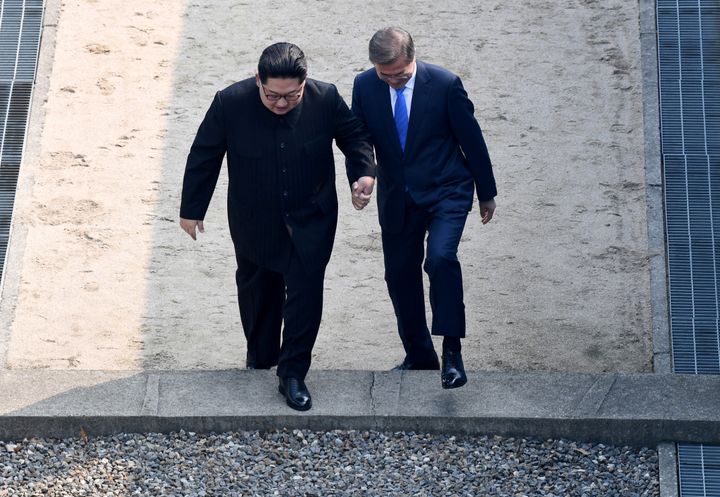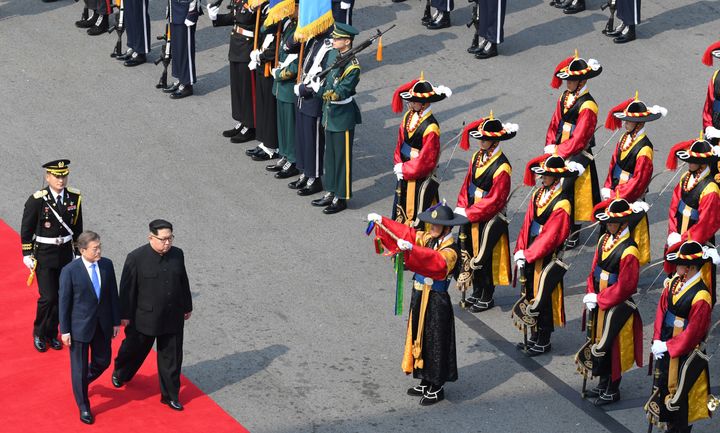The leaders of North and South Korea have signed a declaration agreeing to work on the “complete denuclearisation of the Korean peninsula”.
At their first summit in more than a decade, the two sides announced they would seek an agreement to establish permanent and solid peace on the peninsula.
The declaration included promises to pursue military arms reduction, cease “hostile acts”, turn their fortified border into a “peace zone”, and seek multilateral talks with other countries, including the US.
The news came hours after Kim Jong-Un made history by crossing over the world’s most heavily armed border to greet his rival, South Korean president Moon Jae-in.
Pledging a “new history” in relations with his neighbour, Kim became the first North Korean leader to set foot in South Korea since the end of the Korean War in 1953.
US President Donald Trump responded to the meeting by saying that “good things are happening”, but cautioned, “only time will tell”.
Kim then invited Moon to cross briefly to the northern side with him, before they returned to the southern side for talks on North Korea’s nuclear arsenal.
“I feel like I’m firing a flare at the starting line in the moment of (the two Koreas) writing a new history in North-South relations, peace and prosperity,” Kim told Moon as they sat at a table to begin their closed-door talks.
Moon responded that there were high expectations that they produce an agreement that will be a “big gift to the entire Korean nation and every peace loving person in the world”.
Moon then grasped Kim’s hand and led him along a red carpet into South Korean territory, where school children placed flowers around their necks and an honour guard stood at attention for inspection.
Thousands of journalists were kept in a huge conference centre well away from the summit, except for a small group of tightly-controlled pool reporters at the border.

The two countries fought one of the 20th century’s bloodiest conflicts – and even today occupy a divided peninsula that is still technically in a state of war.
The historic summit follows months of heightened tensions between the US, its ally South Korea and the North, with Trump and Kim engaging in tit-for-tat threats that some feared would end in nuclear war.
On New Year’s Day, Kim asserted: “The entire area of the US mainland is within our nuclear strike range. The United States can never start a war against me and our country.”
Trump tweeted in response, “I too have a Nuclear Button, but it is a much bigger & more powerful one than his, and my Button works!”
However, in recent months tensions have eased considerably. Over Easter, the US Secretary of State, Mike Pompeo, held a secret preliminary meeting with Kim. Trump has since suggested he may meet Kim at a summit in the coming months.
What next for diplomacy?
Beyond the ceremony and photo opportunities, it is still not clear whether Kim and Moon can make any progress in talks on the nuclear issue, which has hung over US and South Korean officials for decades.
North Korea’s nuclear and missile tests last year likely put it on the threshold of becoming a legitimate nuclear power. North Korea claims it has already risen to that level.
The Korean state news agency said that the leader would “open-heartedly” discuss with Moon “all the issues arising in improving inter-Korean relations and achieving peace, prosperity and reunification of the Korean peninsula” in a “historic” summit.


And What Next For Nuclear Weapons?
Nuclear weapons are the top talking point of Friday’s summit. The meeting is set to provide the clearest sign yet of whether it is possible to peacefully negotiate with a country that has spent decades building its arsenal, despite crippling sanctions and near-constant international criticism.
Expectations are low, given that past so-called breakthroughs on North Korea’s weapons have collapsed amid acrimonious charges of cheating and bad faith.
Sceptics of engagement have long said that the North often turns to interminable rounds of diplomacy meant to ease the pain of sanctions – giving it time to perfect its weapons and win aid for unfulfilled nuclear promises.
Advocates of engagement say the only way to get a deal is to do what the Koreas will try on Friday: sit down and see what is possible.
South Korea’s Moon, a liberal whose election last year ended a decade of conservative rule in Seoul, will be looking to make some headway on the North’s nuclear programme in advance of a planned summit in several weeks between Kim and US president Donald Trump.
Kim, the third member of his family to rule his nation with absolute power, is eager, both in this meeting and in the Trump summit, to talk about the nearly 30,000 heavily armed US troops stationed in South Korea and the lack of a formal peace treaty ending the Korea War – two factors, the North says, that make nuclear weapons necessary.
North Korea may also be looking to use whatever happens in the talks with Moon to set up the Trump talks, which it may see as a way to legitimise its declared status as a nuclear power.

